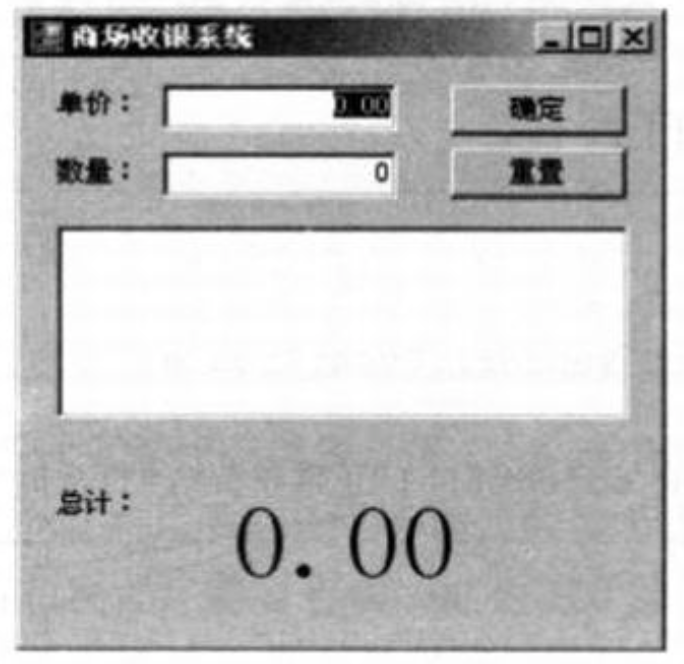iOS-策略模式
在实际开发过程中,app需求都是由产品那边给出,往往是他给出第一版功能,我们写好代码后,会相应的给出第二版、第三版功能,而这些功能是在实际使用中,根据用户需求而不断增加的。如果在编码之初,我们并未认识到这一点,并未后续添加的代码做好相应的设计准备,那么无疑,这个项目代码会越来越乱,就会导致这样一个循环:
- 产品提需求
- 我根据需求写代码
- 产品增加需求
- 为了在规定时间内完成任务,我根据需要增加的需求增加代码(由于没有思考好相应的设计,使得代码又长又乱)
- 产品再增加需求
- 我再增加代码,由于前面代码设计不合理,使得即使只增加一个小小的功能,我整个项目各个地方都要添加这样的代码
- 产品觉得某个功能不好,要删掉,然后我得在项目中找到各种地方对应功能的代码,删掉,还得撸顺上下的逻辑关系
- 这样子,发现工作量好大、没时间看书、没时间学习,总是撸相同质量的代码,技能得不到提升
- 如果不从自己身上找原因,就开始骂产品,有事没事总增加需求,觉得呆在这公司没意思,然后辞职......
- 下一家公司,又开始这样的循环......
在知乎上看到这样一个问答:
是不是程序员都感觉不幸福?过得很不好?因为不管bat公司还是中小公司,各种加班、天天撸代码,没时间谈女朋友.......
看到这样一个很赞的回答:技术好的,都过得不错,技术差的......
- 现在有这样一个任务,做一个商场收银软件,营业员根据客户所购买的商品的单价和数量,向客户收费。
很简单的一个需求,稍微分析就可以得到下图的界面:
根据界面,也可以很快的将主要代码写出来:
|
1
2
3
4
5
6
7
8
9
10
11
12
13
14
15
16
17
18
19
20
21
22
23
24
25
26
27
28
29
30
|
#import <Foundation/Foundation.h>@interface ZYTotalPrices : NSObject@property (nonatomic, assign) double singlePrices;@property (nonatomic, assign) int number;- (instancetype)initWithSinglePrices:(NSString *)singlePrices number:(NSString *)number;- (double)totalPrices;@end#import "ZYTotalPrices.h"@implementation ZYTotalPrices- (instancetype)initWithSinglePrices:(NSString *)singlePrices number:(NSString *)number{ if (self = [super init]) { self.number = [number intValue]; self.singlePrices = [singlePrices doubleValue]; } return self;}- (double)totalPrices{ return self.number * self.singlePrices;}@end |
然后产品跑过来和你说,现在有新的需求了,商场促销,所有商品打八折。
想想,直接在- (double)totalPrices 方法里面,再乘以0.8就ok了......这样是满足了现有的需求,那要是某天商场打七折或者说,打完折回复原价,怎么办?
2. 增加打折
其实,只需要增加一个下拉选择框,让收银员选择当前的打折就可以了,主要代码如下:
|
1
2
3
4
5
6
7
8
9
10
11
12
13
14
15
16
17
18
19
20
21
22
23
24
25
26
27
28
29
30
31
32
33
34
35
36
37
38
39
40
41
42
43
44
45
46
47
48
49
50
51
52
53
54
55
56
57
58
59
60
61
62
63
64
65
66
67
68
69
70
71
72
73
74
75
76
77
78
79
80
81
82
83
84
|
#import <Foundation/Foundation.h>@interface ZYTotalPrices : NSObject@property (nonatomic, assign) double singlePrices;@property (nonatomic, assign) int number;/** * 下拉菜单中的某个属性字符串 */@property (nonatomic, copy) NSString *itemStr;- (instancetype)initWithSinglePrices:(NSString *)singlePrices number:(NSString *)number;- (double)totalPrices;@end#import "ZYTotalPrices.h"@interface ZYTotalPrices ()/** * 打折语句 */@property (nonatomic, strong) NSArray *discountStrs;/** * 打折的具体数值 */@property (nonatomic, strong) NSArray *discountNumbers;/** * 打折对应下标 */@property (nonatomic, assign) int index;@end@implementation ZYTotalPrices- (NSArray *)discountNumbers{ if (!_discountNumbers) { _discountNumbers = @[@(1), @(0.8), @(0.5)]; } return _discountNumbers;}- (NSArray *)discountStrs{ if (!_discountStrs) { _discountStrs = @[@"正常收费", @"打八折", @"打五折"]; // 默认为正常收费 self.index = 0; } return _discountStrs;}- (void)setItemStr:(NSString *)itemStr{ _itemStr = [itemStr copy]; [self.discountStrs enumerateObjectsUsingBlock:^(NSString *obj, NSUInteger idx, BOOL *stop) { if ([obj isEqualToString:itemStr]) { self.index = (int)idx; *stop = YES; } }];}- (instancetype)initWithSinglePrices:(NSString *)singlePrices number:(NSString *)number{ if (self = [super init]) { self.number = [number intValue]; self.singlePrices = [singlePrices doubleValue]; } return self;}- (double)totalPrices{ double tempNumber = [self.discountNumbers[self.index] doubleValue]; return self.number * self.singlePrices * tempNumber;}@end |
差不多就有了下面这样的界面:(请勿完全对照)
这时候,产品过来说,需要增加“满300送100”的活动。这完全是可以在类里多增加一个方法,来计算这个的。但是,这种方法并不好,事实上,
我们完全可以抽出一个抽象基类出来,基类里面有个方法,就是返回总的钱数,而各个不同算法的子类继承自这个基类,实现基类里面的方法,然后用工具类根据不同的需求调用不同的子类,这样的话,分工很明确,如果有什么特殊的需求,找到这个子类增加就ok
3. 简单工厂模式
需要注意的是,其实打八折、七折、六折...完全是可以用个变量来表示的,没必要衍生出很多子类,直接就是一个打折子类,内部确定打折的具体折数;同理,满**减**也是如此。
面向对象编程,并不是类越多越好,类的划分是为了封装,但划分类的基础是抽象,具有相同属性和功能的对象的抽象集合才是类。
打多少折,只是形式的不同,抽象分析出来,所有的打折算法是一样的,所有打折算法应该是一个类。同理,满**减**也是如此。
代码如下:
|
1
2
3
4
5
6
7
8
9
10
11
12
13
14
15
16
17
|
抽象基类:#import <Foundation/Foundation.h>@interface ZYTotalPrices : NSObject@property (nonatomic, assign) double singlePrices;@property (nonatomic, assign) int number;/** * 如此,抽象类里面有一个方法声明,实现交给子类 * */- (double)totalPrices;@end#import "ZYTotalPrices.h"@implementation ZYTotalPrices@end |
|
1
2
3
4
5
6
7
8
9
10
11
12
13
14
15
16
17
18
19
20
|
正常价格:#import "ZYTotalPrices.h"@interface ZYPricesNoraml : ZYTotalPrices@end#import "ZYPricesNoraml.h"@implementation ZYPricesNoraml/** * 正常收费 * */- (double)totalPrices{ return self.singlePrices * self.number;}@end |
|
1
2
3
4
5
6
7
8
9
10
11
12
13
14
15
16
17
18
19
20
21
22
23
24
25
26
27
28
29
30
31
|
打折:#import "ZYTotalPrices.h"@interface ZYPricesDiscount : ZYTotalPrices/** * 打折率,为小数 */@property (nonatomic, assign) double moneyRebate;- (instancetype)initWithMoneyRebate:(double)moneyRebate;@end#import "ZYPricesDiscount.h"@implementation ZYPricesDiscount- (instancetype)initWithMoneyRebate:(double)moneyRebate{ if (self = [super init]) { self.moneyRebate = moneyRebate; } return self;}- (double)totalPrices{ return self.number * self.singlePrices * self.moneyRebate;}@end |
|
1
2
3
4
5
6
7
8
9
10
11
12
13
14
15
16
17
18
19
20
21
22
23
24
25
26
27
28
29
30
31
32
33
34
35
36
37
|
返利:#import "ZYTotalPrices.h"@interface ZYPricesReturn : ZYTotalPrices/** * 返利条件 */@property (nonatomic, assign) double moneyCondition;/** * 返利值 */@property (nonatomic, assign) double moneyReturn;- (instancetype)initWithMoneyCondition:(double)moneyCondition moneyReturn:(double)moneyReturn;@end#import "ZYPricesReturn.h"@implementation ZYPricesReturn- (instancetype)initWithMoneyCondition:(double)moneyCondition moneyReturn:(double)moneyReturn{ if (self = [super init]) { self.moneyCondition = moneyCondition; self.moneyReturn = moneyReturn; } return self;}- (double)totalPrices{ double total = self.number * self.singlePrices; return total - (int)(total / self.moneyCondition) * self.moneyReturn;}@end |
|
1
2
3
4
5
6
7
8
9
10
11
12
13
14
15
16
17
18
19
20
21
22
23
24
25
26
27
28
29
30
31
32
33
34
35
36
37
38
39
40
41
42
43
44
45
46
47
48
49
50
51
52
53
|
工具类:#import <Foundation/Foundation.h>@class ZYTotalPrices;@interface ZYPricesTool : NSObject+ (ZYTotalPrices *)createTotalPricesWithItemStr:(NSString *)itemStr;@end#import "ZYPricesTool.h"#import "ZYPricesNoraml.h"#import "ZYPricesDiscount.h"#import "ZYPricesReturn.h"static NSArray *_arrayStrs;@implementation ZYPricesTool+ (NSArray *)arrayStrs{ if (_arrayStrs == nil) { _arrayStrs = @[@"正常收费", @"满300返100", @"打八折"]; } return _arrayStrs;}+ (ZYTotalPrices *)createTotalPricesWithItemStr:(NSString *)itemStr{ [self arrayStrs]; __block int index = 0; [_arrayStrs enumerateObjectsUsingBlock:^(NSString *obj, NSUInteger idx, BOOL *stop) { if ([obj isEqualToString:itemStr]) { index = (int)idx; *stop = YES; } }]; switch (index) { case 0: return [[ZYPricesNoraml alloc] init]; break; case 1: return [[ZYPricesReturn alloc] initWithMoneyCondition:300 moneyReturn:100]; break; case 2: return [[ZYPricesDiscount alloc] initWithMoneyRebate:0.8]; break; } return nil;}@end |
|
1
2
3
4
5
6
7
8
9
10
11
12
13
14
15
16
17
18
19
20
21
22
23
24
25
|
控制器内代码:#import "ViewController.h"#import "ZYPricesTool.h"#import "ZYPricesNoraml.h"#import "ZYPricesDiscount.h"#import "ZYPricesReturn.h"@interface ViewController ()@end@implementation ViewController- (void)viewDidLoad { [super viewDidLoad]; // Do any additional setup after loading the view, typically from a nib. ZYTotalPrices *totalPrices = [ZYPricesTool createTotalPricesWithItemStr:@"打八折"]; totalPrices.number = 5; totalPrices.singlePrices = 6; NSLog(@"%lf",[totalPrices totalPrices]);}@end |
这次,不论产品跑过要求怎么修改,都可以很简单的实现了。比如说,要“满500返200”,直接在ZYPricesTool里面增加一个就好,算法完全不需要重新写。如果又有一种需求,"满100元返积分10点,一次购物到一定积分,赠送礼物",直接产生一个继承自ZYTotalPrices的子类,在里面写产生积分的算法,然后在工具类里面增加响应处理即可,其他已经处理了的类,完全不需要去改动。
但是,也是优缺点,虽然简单的工厂设计模式解决了这个问题,但是这个模式只是解决了对象的创建问题,而且由于工厂本身包含了所有的收费方式,商场是有可能经常性的更改打折额度和返利额度,每次维护和扩展收费方式都要更改这个工厂类,以至于代码需要重新编译、部署,那这种处理方式就显得比较糟糕了。面对算法的时常变动,应该有更好的设计方法......
4. 策略模式
策略模式定义了算法家族,分别封装起来,让它们之间可以相互替换,此模式让算法的变化,不会影响到使用算法的客户。
商场收银时如何促销,用打折还是返利,其实都是一些算法,用工厂来生成算法对象,这没错,但是算法本身只是一种策略,最主要的是,这些算法本身是可以随时替换的,这就是变化点,而封装变化点是面向对象的一种很重要的思维方式。
接下来就是策略模式代码:
|
1
2
3
4
5
6
7
8
9
10
11
12
13
14
15
|
#import <Foundation/Foundation.h>@interface ZYTotalPrices : NSObject@property (nonatomic, assign) double singlePrices;@property (nonatomic, assign) int number;/** * 如此,抽象类里面有一个方法声明,实现交给子类 * */- (double)totalPrices;@end#import "ZYTotalPrices.h"@implementation ZYTotalPrices@end |
|
1
2
3
4
5
6
7
8
9
10
11
12
13
14
15
16
17
18
19
|
#import "ZYTotalPrices.h"@interface ZYPricesNoraml : ZYTotalPrices@end#import "ZYPricesNoraml.h"@implementation ZYPricesNoraml/** * 正常收费 * */- (double)totalPrices{ return self.singlePrices * self.number;}@end |
|
1
2
3
4
5
6
7
8
9
10
11
12
13
14
15
16
17
18
19
20
21
22
23
24
25
26
27
28
29
|
#import "ZYTotalPrices.h"@interface ZYPricesDiscount : ZYTotalPrices/** * 打折率,为小数 */@property (nonatomic, assign) double moneyRebate;- (instancetype)initWithMoneyRebate:(double)moneyRebate;@end#import "ZYPricesDiscount.h"@implementation ZYPricesDiscount- (instancetype)initWithMoneyRebate:(double)moneyRebate{ if (self = [super init]) { self.moneyRebate = moneyRebate; } return self;}- (double)totalPrices{ return self.number * self.singlePrices * self.moneyRebate;}@end |
|
1
2
3
4
5
6
7
8
9
10
11
12
13
14
15
16
17
18
19
20
21
22
23
24
25
26
27
28
29
30
31
32
33
34
35
|
#import "ZYTotalPrices.h"@interface ZYPricesReturn : ZYTotalPrices/** * 返利条件 */@property (nonatomic, assign) double moneyCondition;/** * 返利值 */@property (nonatomic, assign) double moneyReturn;- (instancetype)initWithMoneyCondition:(double)moneyCondition moneyReturn:(double)moneyReturn;@end#import "ZYPricesReturn.h"@implementation ZYPricesReturn- (instancetype)initWithMoneyCondition:(double)moneyCondition moneyReturn:(double)moneyReturn{ if (self = [super init]) { self.moneyCondition = moneyCondition; self.moneyReturn = moneyReturn; } return self;}- (double)totalPrices{ double total = self.number * self.singlePrices; return total - (int)(total / self.moneyCondition) * self.moneyReturn;}@end |
|
1
2
3
4
5
6
7
8
9
10
11
12
13
14
15
16
17
18
19
20
21
22
23
24
25
26
27
28
29
30
31
32
33
34
35
36
37
38
39
40
41
42
43
44
45
46
47
48
|
#import <Foundation/Foundation.h>@class ZYTotalPrices;@interface ZYPricesContent : NSObject@property (nonatomic, strong) ZYTotalPrices *totalPrice;/** * 必须根据相应的itemStr字符串创建对应的算法对象 * */- (instancetype)initWithItemStr:(NSString *)itemStr;- (double)getResult;@end#import "ZYPricesContent.h"#import "ZYTotalPrices.h"#import "ZYPricesNoraml.h"#import "ZYPricesDiscount.h"#import "ZYPricesReturn.h"@implementation ZYPricesContent- (instancetype)initWithItemStr:(NSString *)itemStr{ if (self = [super init]) { [self commitInit:itemStr]; } return self;}- (void)commitInit:(NSString *)itemStr{ if ([itemStr isEqualToString:@"正常收费"]) { self.totalPrice = [[ZYPricesNoraml alloc] init]; } else if ([itemStr isEqualToString:@"满300返100"]) { self.totalPrice = [[ZYPricesReturn alloc] initWithMoneyCondition:300 moneyReturn:100]; } else { self.totalPrice = [[ZYPricesDiscount alloc] initWithMoneyRebate:0.8]; }}- (double)getResult{ return [self.totalPrice totalPrices];}@end |
仔细看这一次的代码,会发现,和上面用工厂调用的代码基本没什么变化,只是将工具类,改成了ZYPricesReturn类,这个类包含ZYTotalPrices类,持有ZYTotalPrices对象,还有就是原本在工具类里面判断的,具体调用哪个算法对象,也在ZYPricesReturn类里面实现了,可以说,ZYPricesReturn类就是为了ZYTotalPrices服务的。
来看看viewController里面的代码,就可以看出很明显的区别,也可以了解策略模式的好处在哪:
先是,调用工具类的viewController代码:
|
1
2
3
4
5
6
7
8
9
10
11
12
13
14
15
16
17
18
19
20
21
22
23
24
|
#import "ViewController.h"#import "ZYPricesTool.h"#import "ZYPricesNoraml.h"#import "ZYPricesDiscount.h"#import "ZYPricesReturn.h"@interface ViewController ()@end@implementation ViewController- (void)viewDidLoad { [super viewDidLoad]; // Do any additional setup after loading the view, typically from a nib. ZYTotalPrices *totalPrices = [ZYPricesTool createTotalPricesWithItemStr:@"打八折"]; totalPrices.number = 5; totalPrices.singlePrices = 6; NSLog(@"%lf",[totalPrices totalPrices]); }@end |
可以很明显的发现,这种方法实现的,viewController想要调用各种算法,那么就得包含各种算法的头文件,创建并持有各种算法对象。
那么,如果是策略模式实现的代码,viewController里面的代码是怎么样的呢:
|
1
2
3
4
5
6
7
8
9
10
11
12
13
14
15
16
17
18
19
|
#import "ViewController.h"#import "ZYPricesContent.h"#import "ZYTotalPrices.h"@interface ViewController ()@end@implementation ViewController- (void)viewDidLoad { [super viewDidLoad]; ZYPricesContent *content = [[ZYPricesContent alloc] initWithItemStr:@"满300返100"]; content.totalPrice.number = 5; content.totalPrice.singlePrices = 120; NSLog(@"%lf",[content getResult]);}@end |
可以看到,viewController只需要认识ZYTotalPrices与ZYPricesContent这两个类即可,不必去认识各种算法类,大大降低了耦合度。
回头来反思下策略模式,策略模式是一种定义一系列算法的方法,从概念上看,所有这些算法完成的都是相同的工作,只是实现不同,他可以以相同的方式调用所有的算法,减少了各种算法类和使用各算法类之间的耦合。
策略模式就是用来封装算法的,但是在实际应用中,我们可以用它来封装几乎任何类型的规则,只要在分析过程中听到需要在不同时间应用不同的业务规则,就可以考虑使用策略模式处理这种变化的可能性。





